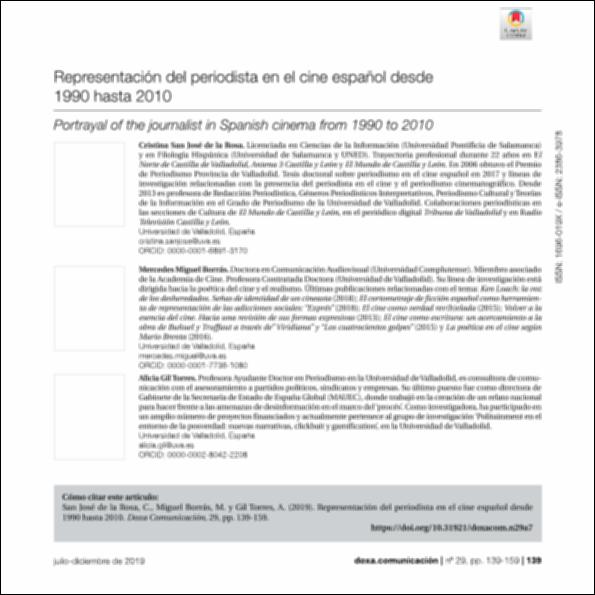Please use this identifier to cite or link to this item:
http://hdl.handle.net/10637/10739Representación del periodista en el cine español desde 1990 hasta 2010

See/Open:
es_a7_stamped.pdf
Español
994,19 kB
Adobe PDF
See/Open:
en_a7_stamped.pdf
English
665,32 kB
Adobe PDF
See/Open:
Articulo_7_ES_Doxa_29_EPUB.epub
Español
903,34 kB
EPUB
See/Open:
Articulo_7_EN_Doxa_29_EPUB.epub
961,21 kB
EPUB
| Title: | Representación del periodista en el cine español desde
1990 hasta 2010 Portrayal of the journalist in Spanish cinema from 1990 to 2010 |
| Authors : | San José de la Rosa, Cristina Miguel Borrás, Mercedes Gil Torres, Alicia |
| Keywords: | Vladimir Propp; Cine español; Cine de los 90; Rol del periodista; Estructuralismo; Spanish cinema; Cinema of the 90s; Role of the journalist; Structuralism |
| Abstract: | El periodista es un personaje habitual en las películas españolas
y su análisis resulta fundamental para conocer la profesión. Esta
investigación se marca como objetivo identificar el perfil del periodista en el cine desde 1990 hasta 2010, dos décadas de drásticos
cambios en las formas de comunicación en nuestro país. En su
fase empírica, una de las aportaciones fundamentales se encuentra en la recuperación de Morfología del cuento (1928) del ruso Vladimir Propp para establecer desde el estructuralismo las características del informador. Concluye que los héroes se encargan del periodismo serio y los villanos, sobre todo mujeres, protagonizan el ‘boom’ de la televisión con predominio de morbo y mentiras en la pequeña pantalla. The journalist is a regular character in Spanish films, and analysing this role is fundamental in learning more about the profession. The aim of this research is to identify the profile of the journalist in cinema from 1990 to 2010, two decades of drastic changes in the modes of communication in our country. In its empirical phase, one of the fundamental contributions can be found in the recovery of Morphology of the Folktale (1928), by Russian Folklorist-Scholar Vladimir Propp, which can be used to establish the characteristics of the reporter from a structuralist point of view. In this book, the conclusion reached is that the heroes are those in charge of serious journalism, whereas the villains, mainly women, are the stars of the television ‘boom’ with a predominance of morbidity and deceit on the small screen. |
| Description: | En: Doxa Comunicación: revista interdisciplinar de estudios de comunicación y ciencias sociales. e-ISSN 2386-3978 n. 29, 2019, pp 139-159 |
| URI: | http://hdl.handle.net/10637/10739 |
| Rights : | http://creativecommons.org/licenses/by-nc-nd/4.0/deed.es |
| Issue Date: | 11-Dec-2019 |
| Center : | Universidad San Pablo-CEU |
| Appears in Collections: | Doxa.Comunicación nº 029 (2019) |
Items in DSpace are protected by copyright, with all rights reserved, unless otherwise indicated.

